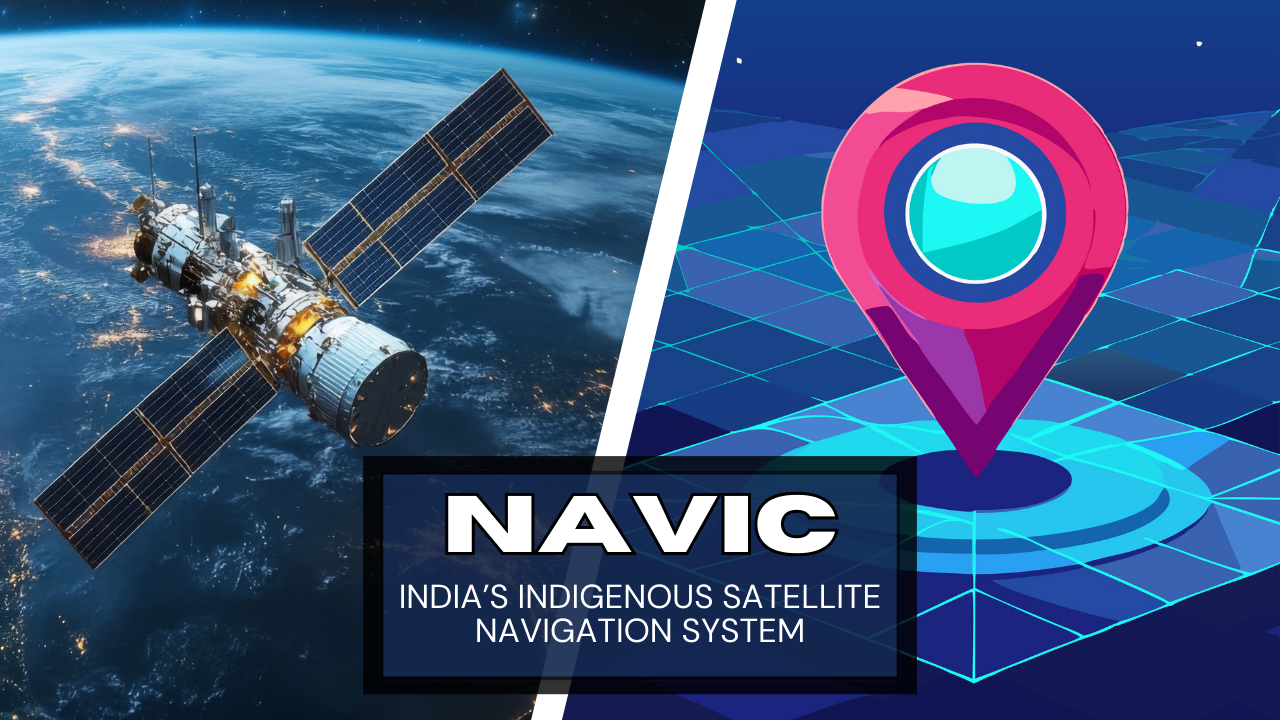NavIC: The Arduous Journey of India’s Indigenous Satellite Navigation System
Introduction – NavIC
Satellite navigation is an essential part of modern life, guiding everything from aeroplanes and ships to smartphones and defence systems. For many years, India depended on foreign satellite navigation systems, particularly the US Global Positioning System (GPS), along with alternatives like Russia’s GLONASS and Europe’s Galileo. While these systems were effective, relying on them meant India was vulnerable to access restrictions, particularly in times of military conflict or geopolitical tension.
The urgency of developing an independent system became clear during the Kargil War of 1999, when India requested GPS data from the United States to track enemy troop movements but was denied access. This incident exposed a crucial weakness in India’s defence infrastructure and underscored the necessity of an indigenous navigation system that could operate without foreign intervention.
In response to this realisation, the Indian government approved the development of a regional satellite navigation system in 2006, led by the Indian Space Research Organisation (ISRO). The project, initially called the Indian Regional Navigation Satellite System (IRNSS) and later renamed Navigation with Indian Constellation (NavIC), aimed to provide accurate, secure, and uninterrupted positioning services over India and a 1,500 km radius beyond its borders.
Designed to cater to both civilian and military applications, NavIC was envisioned as a reliable alternative to GPS, offering greater accuracy and strategic autonomy. However, despite its immense potential, the development of NavIC has not been without hurdles, ranging from technical setbacks and satellite malfunctions to slow adoption and policy challenges.
Development of NavIC and Its Key Features
NavIC operates as a regional satellite navigation system, different from GPS, which is global. While GPS provides worldwide coverage, NavIC is optimised specifically for India and its surrounding areas, ensuring high-accuracy data within its target region. The system consists of a seven-satellite constellation, with three satellites in geostationary orbit (GEO) and four in geosynchronous orbit (GSO). Unlike GPS, which relies mainly on L-band frequencies, NavIC employs a dual-frequency system, using both the L5 Band (1.176 GHz) and the S Band (2.492 GHz). This dual-frequency capability reduces errors caused by atmospheric disturbances, making NavIC more accurate than single-frequency systems like GPS.
NavIC provides two distinct services: Standard Positioning Service (SPS), which is available to all civilian users, and Restricted Service (RS), an encrypted service meant for military and strategic applications. The civilian service offers location accuracy of 5–10 metres, which is better than GPS in India, while the military-grade service provides even greater precision for defence applications. Being a completely indigenous system, NavIC is controlled by Indian ground stations, ensuring that its operations remain free from foreign interference. Given these advantages, NavIC has the potential to revolutionise navigation, positioning, and timing services in India, benefiting a wide range of sectors, including transportation, agriculture, disaster management, and defence.
Challenges Faced in NavIC’s Development
Despite its promising potential, NavIC has encountered multiple setbacks, significantly delaying its full-scale implementation. One of the primary challenges has been satellite malfunctions and launch failures. The system was initially expected to be operational by 2011, but technical difficulties led to repeated delays. The first satellite, IRNSS-1A, was successfully launched in 2013, marking a key milestone in the project.
However, by 2016, all three of its rubidium atomic clocks—critical for precise timekeeping and accurate positioning—had failed, rendering the satellite ineffective. This setback forced ISRO to accelerate plans for a replacement, but further complications arose when the intended substitute, IRNSS-1H, failed to separate from its launch vehicle in 2017, leading to another delay. Eventually, in 2018, a successfully deployed satellite, IRNSS-1I, restored functionality to the NavIC constellation.
Technical challenges have persisted even in the newer generation of NavIC satellites. In 2025, the NVS-02 satellite suffered a partial failure due to its engine not firing in space, further demonstrating the difficulties in maintaining a fully operational system. As of early 2025, out of 11 satellites launched since NavIC’s inception, only five are fully operational, with at least one functioning in a partial capacity. These setbacks have significantly impacted the reliability of the system and have delayed its widespread adoption.
Beyond technical failures, NavIC has also struggled with limited global adoption and device compatibility issues. Initially, major smartphone chip manufacturers, including Qualcomm and MediaTek, were reluctant to support NavIC in their chipsets. As a result, for several years, most consumer devices in India continued to rely solely on GPS, GLONASS, and Galileo, even though NavIC had superior accuracy within India. It was only after government intervention in 2019 that Qualcomm began integrating NavIC support into some of its processors, leading to limited adoption in certain Indian smartphones. However, full-scale adoption remains a work in progress, and many smartphones, navigation devices, and vehicle tracking systems still do not prioritise NavIC over GPS.
Another major hurdle has been India’s dependence on foreign components for critical satellite technology. Although NavIC is an indigenous project, key components—such as atomic clocks—were imported from Europe, leading to failures in multiple satellites. Recognising this vulnerability, ISRO has now prioritised developing its own atomic clocks, but achieving complete self-reliance in satellite technology remains a work in progress. Additionally, maintaining ground infrastructure for the system has proven challenging, as tracking stations and data-processing centres require constant upgrades and monitoring to ensure seamless operations.
Future Prospects: Strengthening and Expanding NavIC
Despite these challenges, NavIC has significant potential for growth. ISRO has ambitious plans to expand the NavIC satellite constellation, improving its accuracy, reliability, and coverage. Future enhancements may include increasing the number of satellites, allowing NavIC to transition from a regional system to a more globally competitive alternative to GPS. If successfully expanded, this could boost international adoption, making NavIC a viable option for global positioning services beyond South Asia.
India is also actively promoting greater consumer adoption of NavIC by encouraging smartphone manufacturers, automotive companies, and wearable technology brands to integrate the system. The government is introducing mandatory policies requiring commercial vehicles, emergency services, and smartphone manufacturers to include NavIC compatibility, ensuring wider accessibility in everyday applications. Additionally, ISRO is working on indigenous atomic clocks, which would reduce dependence on foreign suppliers and enhance the reliability of future NavIC satellites.
Technological upgrades are also in progress to refine NavIC’s dual-frequency capabilities, further improving its accuracy, especially for critical applications such as disaster management, defence operations, and autonomous navigation. The system has the potential to significantly boost industries like agriculture, transportation, aviation, and maritime navigation, providing better accuracy for precision farming, fleet tracking, and emergency response operations. If these improvements are successfully implemented, NavIC could become a game-changer in the field of navigation technology.
Conclusion
NavIC is a remarkable milestone in India’s pursuit of technological self-reliance. From being dependent on foreign navigation systems to developing a highly accurate regional alternative, India has demonstrated its growing capabilities in space technology. However, despite its promise, NavIC’s development has been riddled with setbacks, including satellite failures, slow adoption, foreign dependence, and policy hurdles.
Nevertheless, with ongoing improvements, strong policy support, and a focus on expanding its capabilities, NavIC has the potential to compete with global navigation systems and establish India as a leader in space-based navigation technology. As ISRO continues to enhance and refine NavIC, it is poised to play a critical role in India’s digital and defence infrastructure, ensuring a secure, accurate, and fully indigenous navigation system for future generations.
Subscribe to our Youtube Channel for more Valuable Content – TheStudyias
Download the App to Subscribe to our Courses – Thestudyias
The Source’s Authority and Ownership of the Article is Claimed By THE STUDY IAS BY MANIKANT SINGH




